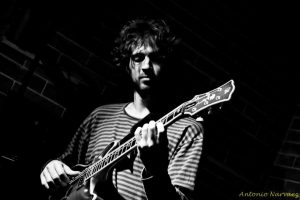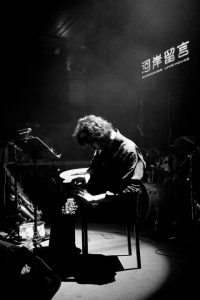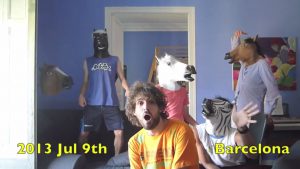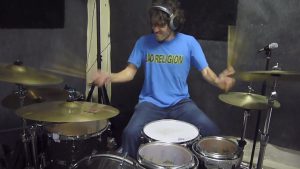I first discovered Spain’s Publio Delgado in 2014 through his video Jones Big Ass truck rentals & storage – Harmonizator (above). While watching, I felt the sense that I was encountering something remarkable. I didn’t know exactly why I felt that way; all I knew in that moment was that I had to see more. Luckily for me, at that point in time Delgado’s channel already had more than 100 videos, so there was a lot to take in. Impressively, in the two years since then, his output has nearly doubled.

Delgado’s most popular videos are his Harmonizator series, which makes up about 40% of his channel. At first glance, these videos are entertaining. They’re bizarre, hilarious, and fun. But upon closer examination, there’s more to them than mere novelty.
In this series, Delgado takes videos, analyzes the pitch content of their audio, and then writes and performs jazz harmony with electric guitars, placing this music over the original. The results demonstrate a virtuoso-level understanding of jazz composition and performance, which is juxtaposed with a spirit of humor, mirth, and utter goofiness. While other artists have done this kind of thing before¹, Delgado’s choice of source videos is what really sets these efforts apart. This sharp disjunction between jazz (an exclusive, high art form) and viral videos (a humorous, absurd distraction that anyone can partake in) is why this series really shines.²
The Harmonizator videos represent a motif found in much of Delgado’s output: coaxing art out from unexpected places, hearing music where others don’t. Music is a mysterious part of human life, and his work sheds some light on its origins in the psyche. While watching, one realizes that music underlies everything that we hear in our daily lives, lurking just beneath the surface. These videos indicate that we may enjoy music because it mirrors aspects of the world in which we live. The fact that the Harmonizator catalog is so gigantic magnifies both the musical implications and the ludicrous, humorous aspects of the series even further.
Unsurprisingly, as Delgado’s videos went viral themselves (along with similar videos from his compeer and one-time collaborator MonoNeon³), many musicians began making copycat videos. There are now subsections of the internet dedicated to the practice, though at this point in time Delgado and MonoNeon still produce the most outstanding content.

Outside of bizarre jazz harmony, Delgado’s other focus is solo acoustic guitar work. Since August 2012, he has released an impressive seven acoustic guitar albums. The most recent, Time to Sleep, was put out last August. His guitar work often features elements of the percussive style made popular by musicians like Andy McKee and Kaki King, though at other times he plays more traditionally. Emotionally, this part of his catalog tends to portray thoughtfulness and stoic beauty, reminiscence and longing. It strikes a good balance between playing with feeling and playing in a technically interesting way.
In addition to these two series, Delgado makes whatever other videos he wants when the mood strikes him. These extra videos support the theme of drawing music out from unexpected parts of life. For example, there are a few videos where Delgado finds everyday items that sound like moments from famous songs. There are some videos where he plays arrangements with traditional instruments (electric guitar, upright bass, piano, trombone, vibraphone, koto, ocarina, vocalization, etc.), but then there are many where he plays non-traditional items musically. Here’s a list of some unexpected things that he’s used in compositions: shower wall tiles, glass bottles and cups, marbles, a plastic trash can scraping a tabletop, living bamboo stalks, pots, plates, flexible plastic tubing, and a swimming pool.

The remainder of material in Delgado’s catalog consists of a few short video sets. Early on, the channel featured a series called MHG, where Delgado arranged songs entirely out of sub-second-length video clips. In one of these videos, he recorded two clips per day over an entire year while traveling around the world to recreate Bach’s Cello Suite No. 1. He has also dabbled in a series called Destroying Jazz Standards. As you might expect, these videos take jazz standards and convert them to aggressive versions with punk drumming, distorted guitars, and a spirit of reckless abandon. It’s an awesome idea, and hopefully more will be done with it in the future.
Delgado’s YouTube channel is a goldmine, but at this point his view counts are moderate relative to the YouTube superstars. While browsing through the channel, watching video after video of quality material, one can only wonder how long it will be before Publio Delgado is a household name. If he keeps producing such high-caliber content, it won’t be long.
p.s. In addition to all his talent and effort, he’s a really nice guy. He enthusiastically let me sample his video Unintelligible empanada truck VS dog for my recent math-metal album ADD/Nihilism.
The Interview
Hi Publio, before we begin I would like to thank you for agreeing to do this interview. I am a big fan of your work and it is exciting to learn more about your creative process.

What does your musical history look like? How long have you been making music? Did you attend music school? Have you collaborated with other musicians in the past, or are you collaborating with anyone now?
My father always played guitar and wrote his own songs for fun, so music has always been close to me. I started playing guitar at 16 inspired by Punk-Rock bands, and attended a local music school in Barcelona, my hometown, since age of 18. Five years later I got a scholarship from Berklee College of Music, so I moved to Boston, MA, and spend 3 years there until graduation.
I was a member of many different bands before moving to the States, and had some other projects in Boston and NY as well. Right now I do perform live with other musicians eventually, but I mostly play by myself.
What does the process look like for the creation of a Harmonizator video? Do you know what the guitar melody is going to be before you begin working on the video, or do you have to experiment to find the melody that fits the video?
I first watch the video and try to hear the music on it. If I feel it has some potential I start working on it. I take every phrase one by one and loop them, try to “sing” them, find its notes on my guitar and finally record them. Reproducing the melody is the hardest and most annoying part of the process… but as soon as I’m done, the fun part starts: harmonizing! Finding chords is sometimes really easy and intuitive and it takes me only a few minutes. Some other times I can’t figure it out and it might take hours…
“Improvisation” is included in the Bandcamp tags for your acoustic music. How much of your recorded acoustic guitar music is improvised and how much is pre-written? What does the composition process look like for your acoustic music?
For some parts I have a clear idea of what I want the tune to sound like and every note is decided. For some other parts I just have a slight idea and try to decide how it will end up while recording. I never write charts for them, that gives me way more freedom when I’m performing them, and lets them naturally evolve over the years.
I don’t have any particular method to compose for my solo acoustic project. I just try to take any musical thought out of my mind and remember life experiences instead. Think about that night sky full of stars that blowed me away, or those moments I spent with that girl I fell in love with so strongly… Instead of trying to take control of music, let music take control of my body. It turned out to be the best and most beautiful way for me to create.
You have made quite a few videos over the years that stray from the Harmonizator and acoustic formats. Some of your videos are multitrack compositions and they are outstanding (for example: FFVII – Anxious Heart, Kakariko Village). Is there a reason why your albums are almost entirely solo acoustic guitar music? Have you ever considered making originals in the style of those videos?
Most of the time the only instrument I have access to is my acoustic guitar, so I guess that’s why my albums are mostly acoustic. I’d like to work on some new material with more instruments, though (as I did on a few tracks in my most recent album).

As a musician who comes from a punk background, there are two videos that grabbed my attention the very first time I found your channel: Destroying Jazz Standards. Was there any particular inspiration for these videos? Will we ever see more of this series?
My original idea was to make a bunch of those, but since almost all the instruments I’m using for them are borrowed from friends, and I record them whenever I have a little time when I briefly drop by my hometown, it’s not easy. I definitely wanna make more of them, let’s see if in 2017 I can record at least a couple!
Most of your music is instrumental. In some of your videos, you vocalize, but there are no lyrics. There are only a few videos where you sing words. You are clearly capable of singing lyrics, is there a reason that you usually choose not to?
I always had a hard time singing in front of people, I feel like I’m showing myself naked. Both singing and writing lyrics are too direct for me, I better leave it for people who do it well. I’d rather to say what I have to say through music without words. I do enjoy singing sometimes when nobody else can hear me lol.
There are a few videos on your channel where you are performing live. I see that you have traveled as far as Japan to play. Do you ever tour? If so, where have you performed? Do you have any plans to perform in the US in the future?
I’ve performed in Spain, France, Belgium, Netherlands, Germany, Austria, Hungary, UK, Ireland, Italy, Czech Republic, Italy, Brazil, US, Japan, Taiwan and South Korea. I haven’t been to the States for about 3 years now. I definitely want to go back but don’t know when yet. I’ve only been to the East Coast so I guess next time would be time to visit the west!
Last question: what is your favorite video on your channel right now and why?
It’s hard to choose one between all my videos but I guess it would be the one I harmonized myself as a baby in the bathtub. That childhood video reappeared in my life when I was have a hard time and reminded me of what was really important. And the whole story behind it is beautiful. I had so much fun recording it!
You can support Publio Delgado on Patreon. You can also find him on Facebook. His YouTube channel’s address is youtube.com/vendidou.
¹ Hermeto Pascoal pioneered the general idea used in the Harmonizator videos decades ago.
Henry Hey is a contemporary jazz pianist who inspired the Harmonizator series.
In 1997, Spastic Ink recorded A Wild Hare, a fusion-metal song where the melody follows dialog from Bambi.
² Not every video from the Harmonizator series is based on a viral video, though most are. Delgado sometimes harmonizes mundane footage, which is interesting because of the way it draws music from everyday life. One recent video takes a more serious approach and uses Martin Luther King Jr.’s I Have a Dream speech, which creates a profoundly different effect than the comedy videos.
³ Wondering what the Harmonizator technique sounds like as a full band?
How about what the Harmonizator band sounds like without the original audio?
Some more of the songs with the video muted can be found here.